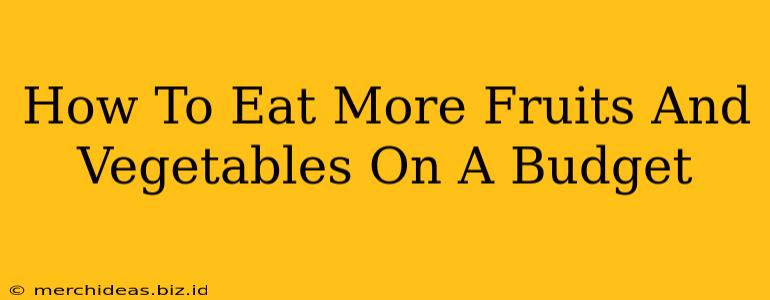Eating a diet rich in fruits and vegetables is crucial for good health. However, the cost can sometimes feel prohibitive, especially for those on a tight budget. This guide will show you how to increase your fruit and vegetable intake without breaking the bank.
Planning is Key: Strategic Shopping for Frugal Fruit and Veggie Lovers
Before you even step foot in the grocery store, planning is essential. This prevents impulse buys and ensures you stick to your budget.
1. Plan Your Meals:
- Create a weekly menu: Planning your meals ahead helps you identify the fruits and vegetables you'll need, minimizing food waste and preventing last-minute, more expensive purchases.
- Consider seasonal produce: Fruits and vegetables that are in season are usually cheaper and tastier. Check your local farmer's market or grocery store flyers for seasonal deals. For example, berries are typically cheaper in the summer.
- Make a shopping list: Sticking to your list is crucial for budget-conscious shopping. Avoid wandering the aisles aimlessly, as this often leads to unplanned purchases.
2. Shop Smart:
- Compare prices: Don't just grab the first thing you see. Compare prices between different brands and sizes to find the best deals. Store brands are often significantly cheaper than name brands, and they're usually just as good.
- Buy in bulk (when appropriate): Buying in bulk can save money on certain items, particularly if you have the storage space. However, be cautious; only buy in bulk if you know you'll use it all before it spoils.
- Frozen is your friend: Frozen fruits and vegetables are often just as nutritious as fresh and are significantly cheaper, especially during the off-season. They're also incredibly convenient.
- Utilize sales and coupons: Check weekly flyers for sales and use coupons whenever possible. Many grocery store apps offer digital coupons.
Maximizing Your Produce: Tips and Tricks for Budget-Friendly Eating
Even with smart shopping, you need to ensure you use all your produce to avoid waste.
1. Proper Storage:
- Store fruits and vegetables correctly: Improper storage leads to spoilage. Learn how to store different types of produce to extend their shelf life. For example, leafy greens last longer if stored in a plastic bag with a paper towel.
- Use leftovers creatively: Don't let leftover vegetables go to waste! Add them to soups, stews, frittatas, or stir-fries. Roasted vegetables make a great side dish.
2. Embrace versatility:
- One vegetable, many meals: A single ingredient can be used in countless ways. For example, carrots can be eaten raw as a snack, roasted as a side dish, or pureed into a soup.
- Experiment with different cooking methods: Different cooking methods bring out different flavors and textures. Try roasting, steaming, sautéing, or grilling your vegetables.
3. Grow Your Own:
- Start small: Even a small herb garden or a few tomato plants can significantly reduce your grocery bill. Consider container gardening if you lack space.
Beyond the Grocery Store: Affordable Ways to Increase Your Intake
There are several ways to incorporate more fruits and vegetables into your diet without relying solely on the grocery store.
- Farmer's Markets: Farmer's markets often offer better prices than grocery stores, particularly on seasonal produce. You may even find deals on slightly imperfect produce, which is perfectly edible.
- Community Gardens: If you have access to a community garden, this is an excellent way to grow your own fruits and vegetables at very little cost.
- Food Banks and Pantries: Food banks and pantries can be a valuable resource for those struggling financially.
By following these tips, you can significantly increase your intake of fruits and vegetables without straining your budget. Remember, small changes can make a big difference in your overall health and well-being. Start implementing these strategies today and enjoy a healthier, more vibrant lifestyle!
